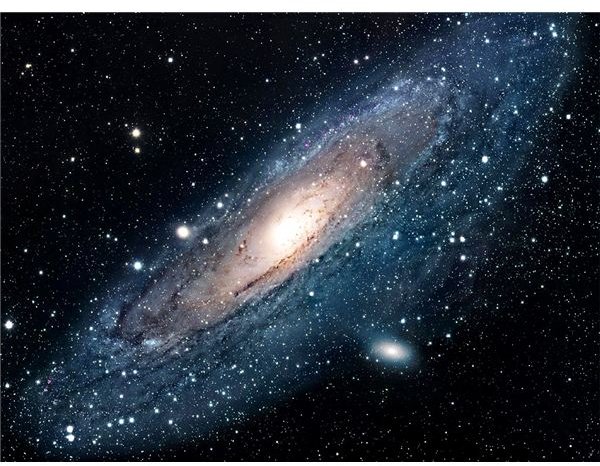Colliding Galaxies: Andromeda and the Milky Way
Galactic Cannibalism: An Over View.
Colliding galaxies are becoming more frequent in the Universe. The recent evidence from space points to the nature of some galaxies to expand at the cost of other galaxies, that is, the massive galaxies are exerting a gravitational force on the smaller ones and thus drawing them in making a larger, composite galaxy. This evidence sheds light onto the origin of the Universe. Recent studies by Peter van Dokkum of Yale University show that galaxies are not in a balanced state but are under strain from forces exerted by other galaxies.
With the Big Bang in the primordial fire, proto galaxies and stars were formed. The galaxies formed were of varying sizes and the bigger ones started to exert force on the smaller ones. Thus, the bigger ones grew in size by eating the smaller ones. In the past, this was all speculation. But, advances in the field of astronomy has made it possible to detect the merging of galaxies. Merging is a complex process which takes millions of years to complete. When a small galaxy starts to orbit around a larger one, the gravitational force of the latter will distort the former. They will orbit each other many times before the eventual collision and subsequent merging.
Will Andromeda and the Milky Way Collide?
Radiation from most of the galaxies shows a red shift and this points to the fact that they are receding from our galaxy, the Milky Way. But there are some other galaxies like the Andromeda Galaxy (M31), part of our local group, which is moving towards the Milky Way, as is evident from the blue shift in the radiation from the Andromeda Galaxy. (See the article on Spectra for more information about blueshift.) Thus**,** the Milky Way is under a collision threat from the Andromeda galaxy.
Currently, Andromeda is at a distance of 2.3 million light years from the Milky Way and it will take millions of years for this merger. The future of the Earth and the Sun after this merger is interesting to imagine. Scientists believe that there is a possibility for the relocation of the Earth, but they dismiss the chances of a collision between stars in the Andromeda and the Earth. This is because the stars in the galaxies are far apart and the chances of the Earth and the Sun colliding with a star in the Andromeda galaxy is minimal. Even though scientists have estimated the speed with which these galaxies are approaching as 120km/sec, they are unable to measure accurately the sideways speed of the Andromeda Galaxy. If the sideways speed is more than what they have calculated, then there is a chance that this collision will never happen.
Conclusion
More and more speculation about the colliding galaxies and the aftermath are arising due to the recent evidence of Andromeda eating its neighbors**.** With the help of Canada-France Hawaii Telescope, scientists at the NRC Herzberg institute for Astrophysics in Victoria had made a map of the Andromeda’s stars. It is the largest map ever made of Andromeda and it extends beyond the galaxy. It showed the presence of a large number of bright stars in the boundary of the Andromeda Galaxy. Since the highest concentration of stars are formed in the center of a galaxy, scientists assumed that these were once part of the dwarf galaxies which are orbiting the Andromeda Galaxy. In addition to this, the map showed that the Triangulum Galaxy, which is at a distance of one million light years from the Andromeda Galaxy is experiencing a strong gravitational pull from Andromeda. Earlier, scientists had ruled out the possibility of Andromeda ripping the stars from Triangulum but these recent findings have shown the enormity of the gravitational force which the Andromeda is capable of exerting on other galaxies.
Who knows what is in store for the Earth. There is a chance that our very distant generations may witness one of the most spectacular events in the history of the Universe.
Sources
https://www.space.com/scienceastronomy/051212_mystery_monday.html
https://www.nasa.gov/audience/forstudents/5-8/features/F_When_Gallaxies_Collide.html
https://www.newscientist.com/article/dn17728-milky-ways-twin-caught-dismembering-neighbour.html
https://hubblesite.org/newscenter/archive/releases/2008/16/image/aa/format/web/
